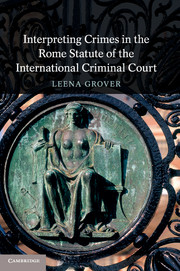Book contents
- Frontmatter
- Dedication
- Contents
- Foreword
- Acknowledgements
- 1 Introduction
- 2 The state of the art
- 3 Guiding interpretive principle
- 4 Challenges to the principle of legality
- 5 Operationalizing the principle of legality
- 6 Custom as an aid to interpretation
- 7 Internal indicia of codification
- 8 External indicia of codification
- 9 The Vienna Convention (1969) and aids to interpretation
- 10 Conclusions
- Bibliography
- Index
- References
6 - Custom as an aid to interpretation
Published online by Cambridge University Press: 05 November 2014
- Frontmatter
- Dedication
- Contents
- Foreword
- Acknowledgements
- 1 Introduction
- 2 The state of the art
- 3 Guiding interpretive principle
- 4 Challenges to the principle of legality
- 5 Operationalizing the principle of legality
- 6 Custom as an aid to interpretation
- 7 Internal indicia of codification
- 8 External indicia of codification
- 9 The Vienna Convention (1969) and aids to interpretation
- 10 Conclusions
- Bibliography
- Index
- References
Summary
Introduction
In Chapter 3, the normative tensions underlying international criminal law were revealed and their potential recurrence in articles 21(3) and 22 of the Rome Statute exposed. The detrimental impact that this apparent normative conflict might have on a method of interpretation for crimes was discussed, and an attempt was made to reconcile the interpretive imperatives in the Rome Statute. It was concluded that the principle of legality is to be the guiding principle of interpretation, and consistency with internationally recognized human rights a background interpretive principle. In Chapters 4 and 5, consideration was given to the content of legality for purposes of interpretation, which resulted in the discerning of guiding interpretive considerations as well as arguments that are consistent and inconsistent with the legality principle.
To review, a method of interpretation is understood to mean a systemic general approach to reasoning through the resolution of interpretive issues. A fully developed method has three tiers. It offers its users, in this case judges of the Court and counsel appearing before them, the following levels of assistance: (1) a primary interpretive principle to guide their reasoning process when confronted with interpretive issues; (2) arguments or reasons that support (and do not support) this interpretive principle; and (3) a catalogue of materials or aids that must, may and, if applicable, may not be taken into account in support of these arguments.
- Type
- Chapter
- Information
- Publisher: Cambridge University PressPrint publication year: 2014



